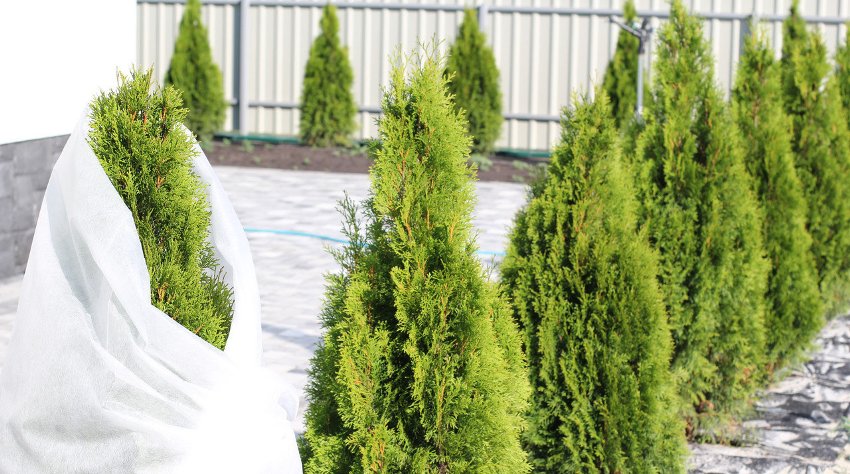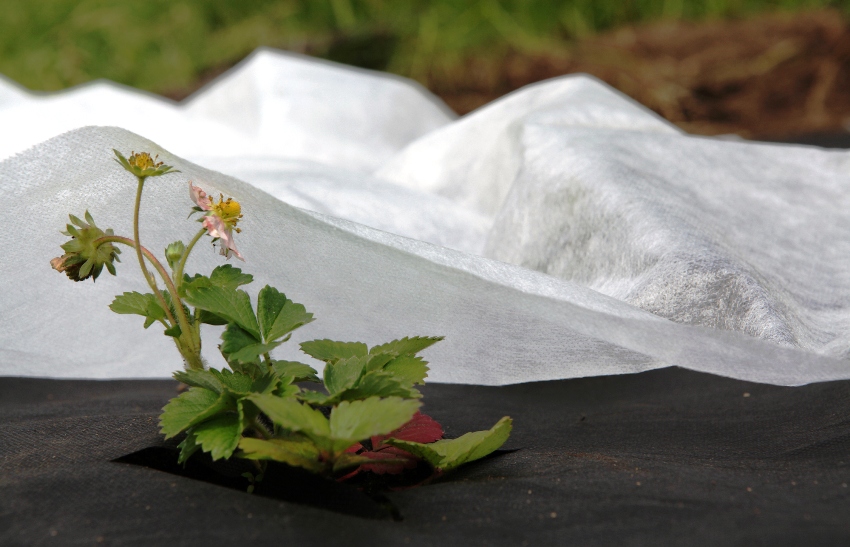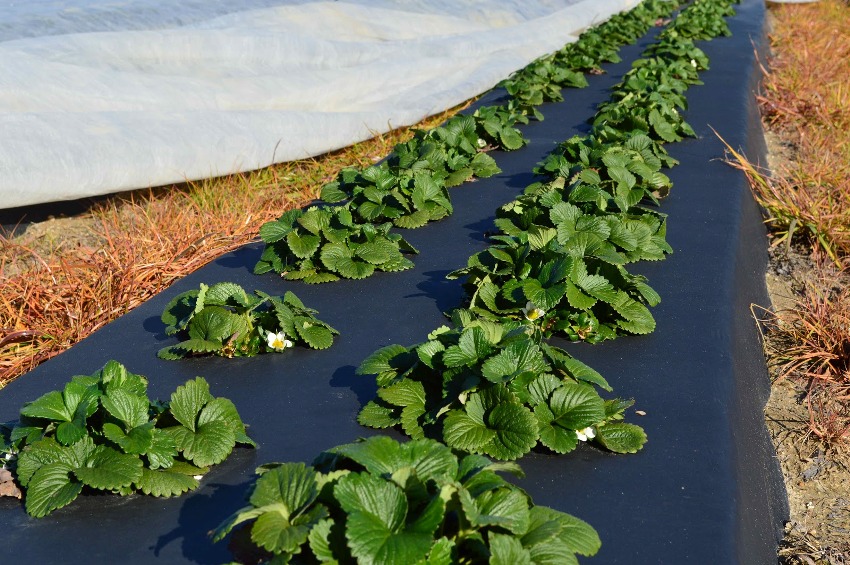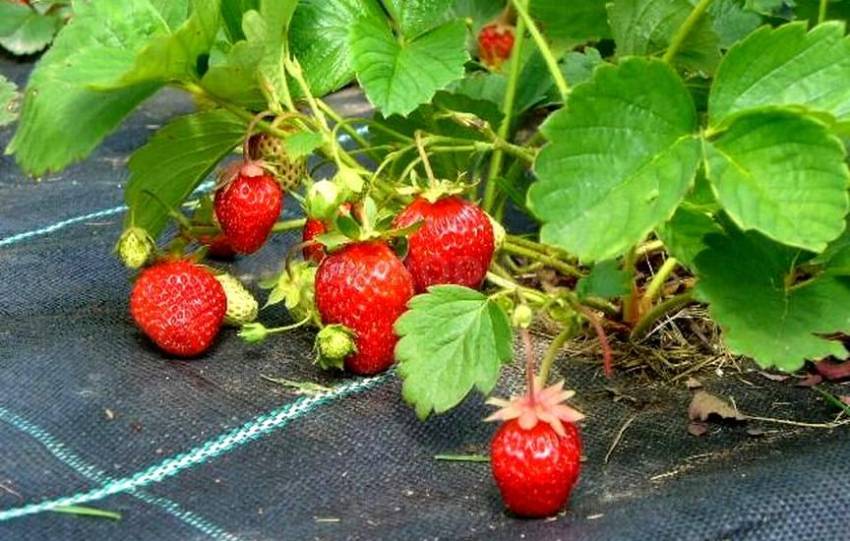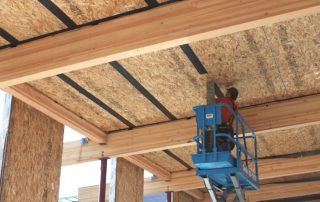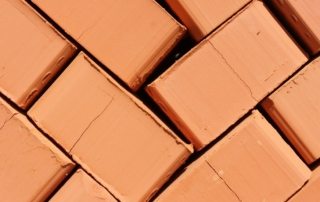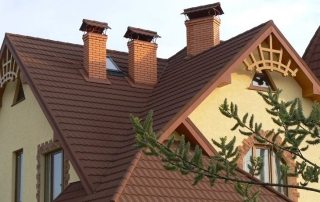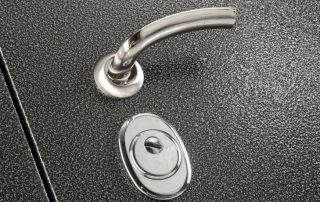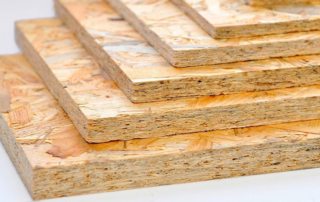Getting a full harvest is the main task of professional and amateur gardeners. They put in a lot of effort, and the result, unfortunately, is not always satisfying. The desire to abandon the use of chemistry in crop production as much as possible and to grow good yields has got a real opportunity to materialize: a new type of polymer covering film has appeared. Spunbond: what it is and how to apply it correctly - the answers to these questions can be found in the content of the proposed article.
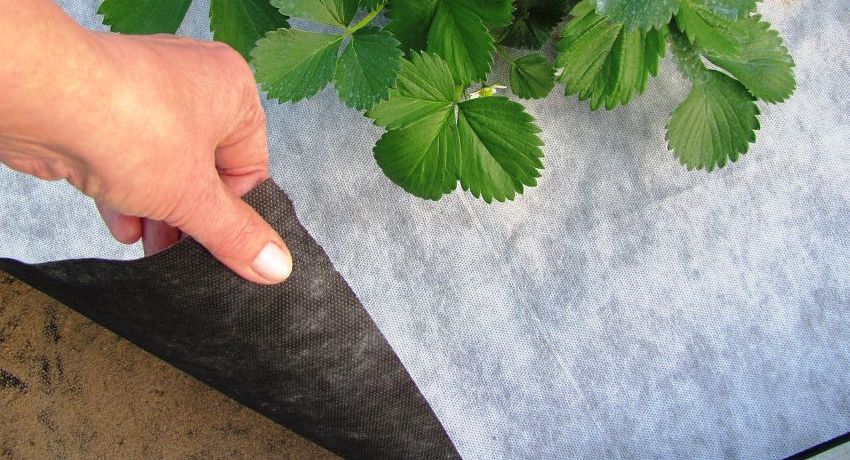
Spunbond is an irreplaceable material for gardeners, especially those who grow vegetables in regions with a cool climate.
Content
- 1 The main purpose of the covering material for plants
- 1.1 Spunbond covering material: main characteristics and types
- 1.2 Varieties and use of white spunbond
- 1.3 Features of using black spunbond
- 1.4 Spunbond price components: density, width, brand
- 1.5 Lutrasil covering material: application and technical characteristics
- 1.6 Characteristics of the covering material Agrotex
- 1.7 How to make a spunbond greenhouse
- 1.8 Black spunbond: what is it. Using material for a strawberry garden
- 1.9 Spunbond: what it is. Progress in the production of covering materials
The main purpose of the covering material for plants
The peculiarities of climatic zones have been studied for a long time. The necessary soil cultivation is carried out, certain types of crops are planted. But more and more often, not only in supermarkets, where goods are imported from various southern countries, but also on market stalls in early spring, you can buy herbs, fresh cucumbers, radishes, tomatoes and even peppers.
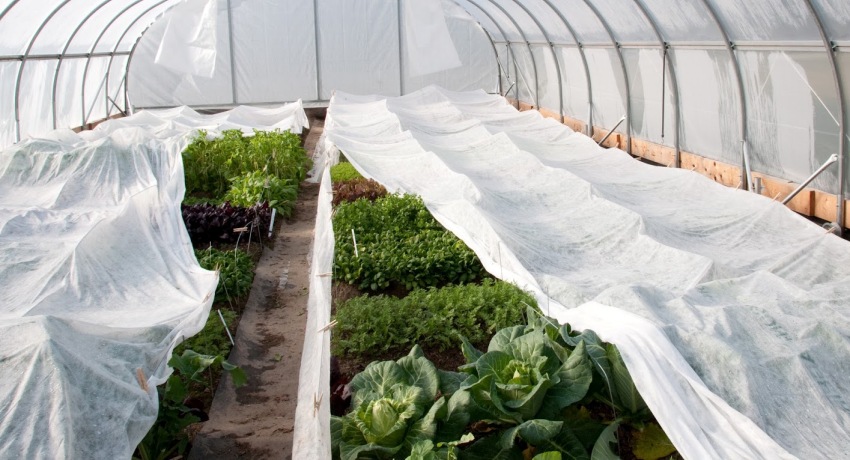
With the help of spunbond, you can easily create optimal conditions on the site for the growth and development of plants throughout the year
Early maturation is achieved in the only way - by creating such temperature conditions for plants under which they can fully develop at an earlier date. For this purpose, greenhouse conditions are created. And here the main component will be the covering material. You can cover the soil so that it warms up and does not lose heat, as well as the seedlings themselves, seedlings, shoots.
Until recently, the function of the covering sheet was performed practically only by polyethylene film. It protects from frost, drying winds, maintains the microclimate for a certain time, but does not allow moisture to pass at all, prevents the full penetration of natural light and weakly protects plants from ultraviolet radiation. When exposed to direct sunlight for a long time, the plastic film becomes cloudy. The term of use of such material is limited to one season.
Spunbond covering material: main characteristics and types
A new type of covering material has appeared, which is called "spunbond". It, in comparison with the film, is more effective for creating a favorable microclimate for plants. A material made from thin filaments separated from polypropylene and bonded by a thermal method is what spunbond is. The name comes from the name of the fabric production technology. The main features of the polymer used made it possible to actively and effectively use spunbond nonwoven material not only in small household plots and summer cottages, but also for growing many crops on an industrial scale.
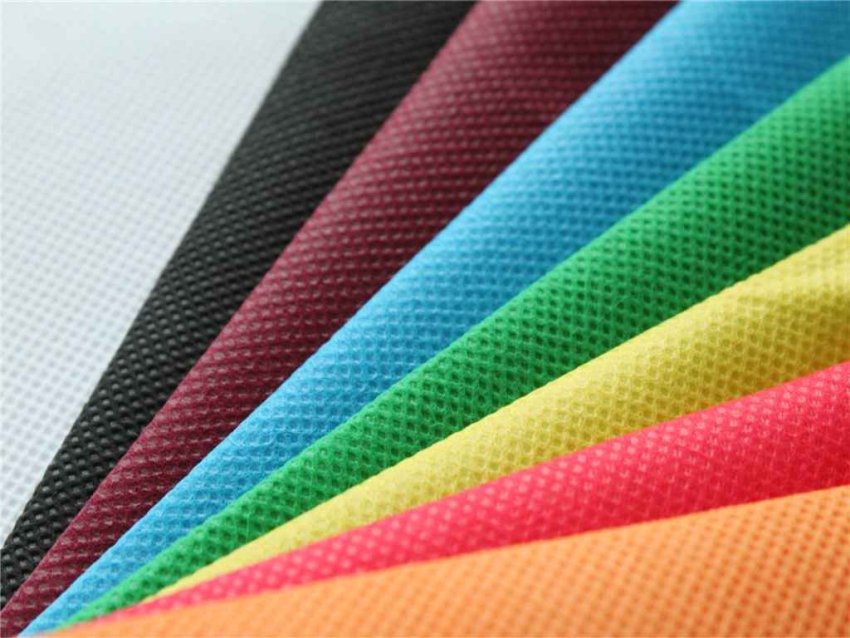
Spunbond consists of environmentally friendly polypropylene - a substance with a fine fibrous structure
Main technical characteristics of spunbond covering material:
- high degree of wear resistance;
- withstands prolonged exposure to high temperatures;
- resistant to moisture;
- lends itself to staining;
- has a wide range of density.
According to its functional orientation, this polymer material can be divided into two types:
- stimulating the development of plants through optimal light and moisture permeability and protection from low temperatures;
- protecting the soil by regulating the water and air regimes in the upper layers (mulching).
Helpful advice! Before purchasing a spunbond, you need to decide what goals are set: soil preservation or plant protection. The simultaneous use of two types of this covering material on the same land plot is undesirable, since the water balance is disturbed.
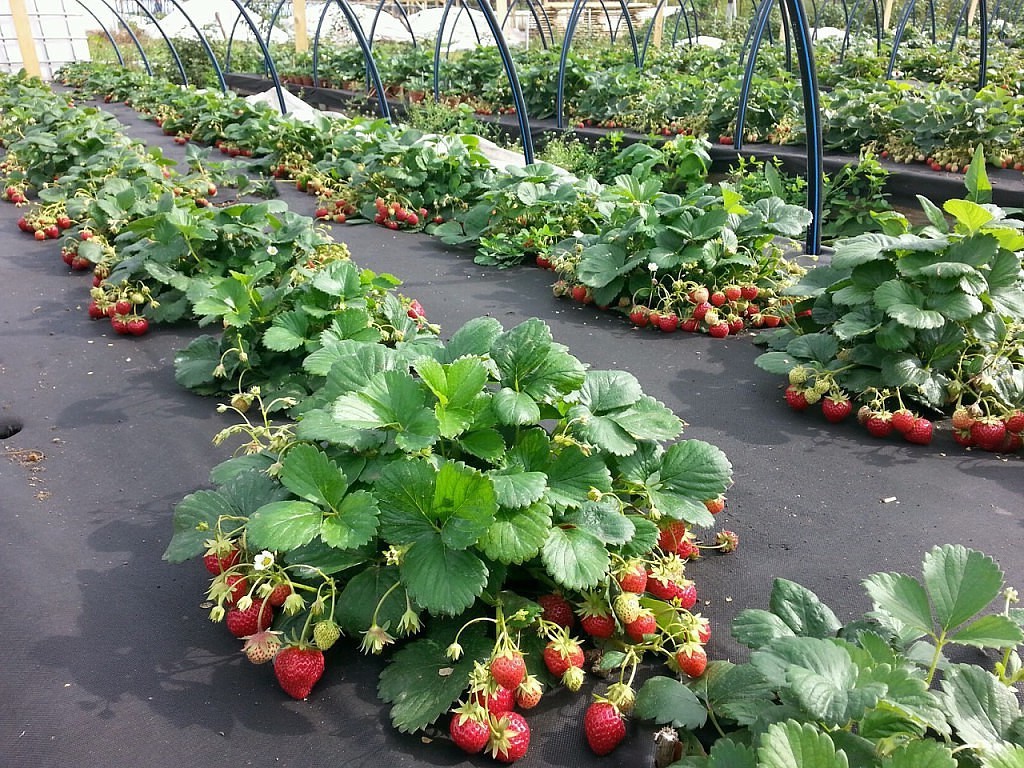
As covering material spunbond can be in the garden and vegetable garden all year round
Depending on the purpose, agrofibre is produced in white and black. The density of spunbond varies from 15 to 160 g / m².
Varieties and use of white spunbond
White agrofibre varies in density and, therefore, in terms of use. The thinnest kind has a density of 17 g / m². This material can protect seedlings or seedlings from temperatures lowered to -2 ° C. Protects from excessive ultraviolet radiation, helps to retain moisture in the upper soil layer, shelters from the wind, from damage to sprouts by insects and birds.
The main advantages of this material:
- lightweight, plants do not break under its weight;
- passes water well, when watering there is no need to remove it;
- provides good air exchange, condensate does not accumulate under it;
- easily unfolds and stows away.
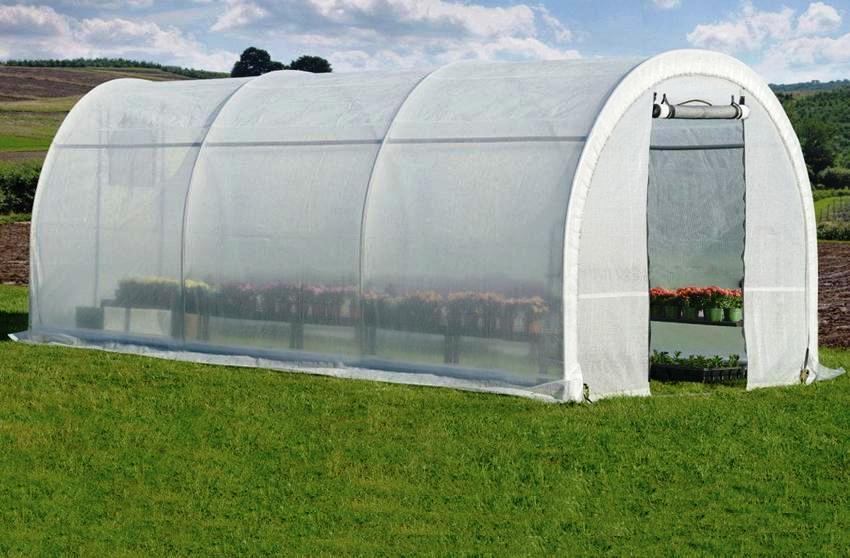
White spunbond can withstand frosts down to -10 ° C, it is used for covering greenhouses and for winterizing perennial crops, trees and shrubs
The use of low density spunbond is advisable when growing early vegetables, flower seedlings and other horticultural crops. After planting the plants, the material must be spread directly on top of the site and the edges must be fixed or sprinkled with earth.
Helpful advice! Do not pierce the material with sharp objects with uneven surfaces so as not to damage the canvas. It is better to use a smooth clip-type mount.
Agrofibre, with a density of 23 g / m², protects crops from frost down to -5 ° C. Transmits sunlight in an optimal amount. Prevents excessive moisture penetration.
The main advantages of this material:
- denser and more durable in use than agrofiber with a density of 17 g / m²;
- the ability to retain water excludes the possibility of plant decay;
- does not restrict breathability.
In addition to the fact that this agrofiber is used in spring to protect plants from adverse weather conditions, and in summer to maintain moisture and protect against ultraviolet radiation, such a covering material is suitable for extending the vegetation of plants in autumn. Not recommended for overlay on wireframes.
Agrofibre with a density of 30 g / m² can protect against temperatures down to -7 ° C. This canvas allows you to plant seedlings in open ground much ahead of schedule.
The main advantages of this material:
- despite its significant density, it does not reduce the degree of penetration of sunlight and air currents;
- can be spread on the ground, as well as small greenhouses;
- withstands a significant layer of snow - up to 5 cm.
In addition to the traditional use (spreading on the ground), this material is convenient for covering the seedlings of thermophilic trees in winter.
Agrofibre with a density of 50 g / m² allows plants to withstand a short-term drop in temperature down to -10 ° C. Creates a greenhouse effect.
The main advantages of this material:
- ensuring accelerated heating of the soil;
- maintaining a high temperature inside the greenhouse for a long time;
- the possibility of very early planting (at the first appearance of spring sunlight) seedlings in open ground;
- durability of use.
The material is recommended for creating greenhouses.
Features of using black spunbond
The black covering material creates a favorable microclimate for the plant parts in the soil. It has a high density - 150 g / m². Moisture permeable, so there is no need to remove it when watering. It does not let in sunlight, thereby retaining moisture in the soil.
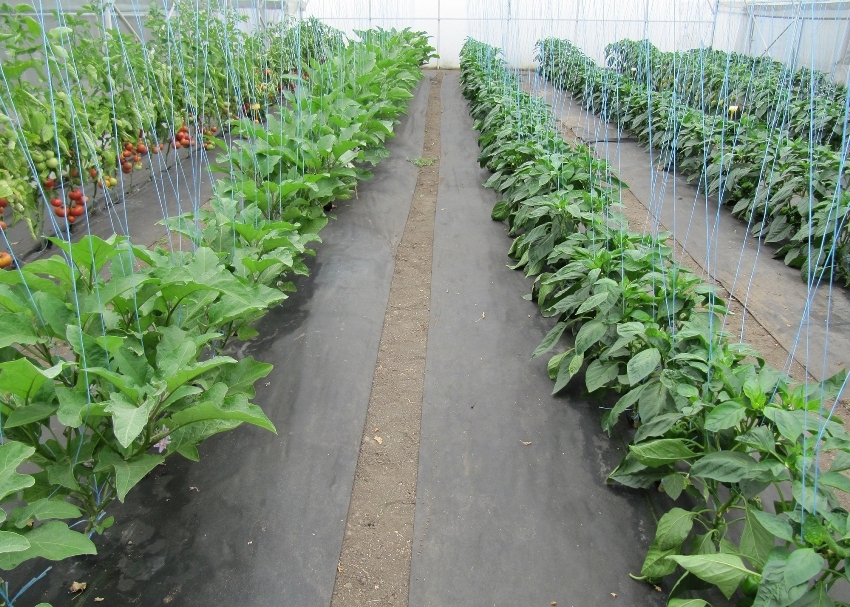
Black spunbond is available in different densities, but for a summer cottage it is recommended to buy at least 17-60 g / m2
The use of black spunbond reliably protects the roots of seedlings in winter, allowing them to withstand temperatures down to -8 ° C. Protects against weeds, saving time and effort in weeding. Protects fruits located close to the soil from contamination and decay.
The main advantages of this material:
- wear resistance;
- lightness with significant density;
- the ability to cover the soil both around berry crops and around large bushes and trees.
Helpful advice! If it is necessary to develop "virgin soil", the most effective remedy is spunbond. Weeding takes time and effort, and herbicides will harm the soil.
Having considered different ways of using spunbond in the photo, gardeners and gardeners will be able to expand the possibilities of its use.
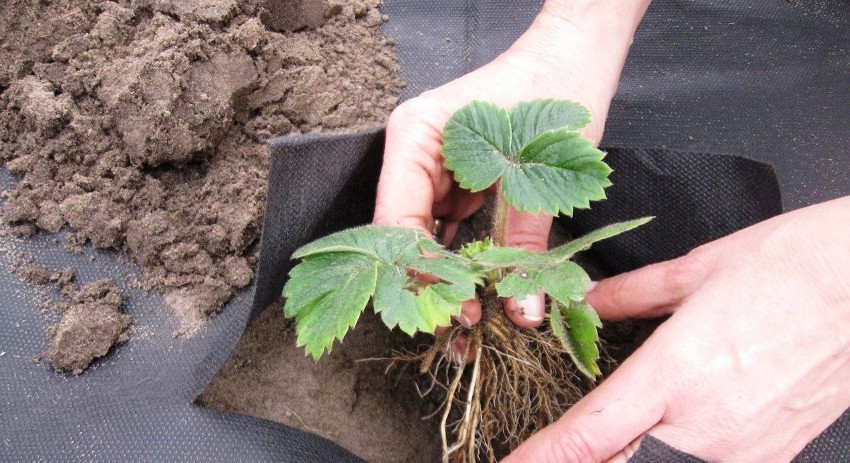
To increase yields, black spunbond is used as mulch - spread on the site and plant in the holes made by plants
Components Spunbond prices: density, width, trade mark
The cost of any product is made up of quantitative and qualitative indicators. Spunbond price per square meter most of all depends on density: the denser the material, the higher the price. It is not difficult to calculate the amount of purchased covering material - the width of the spunbond is traditionally 1.6 or 3.2 m. Agromaterial is sold in rolls and packaged. Below are the prices for domestically produced goods.
You can buy black spunbond at the following cost:
| Density, g /m² | Dimensions, m | Price per roll (packing), rub. |
| 60 | 3.2x10 | 500 (packing) |
| 60 | 3.2x150 | 6.481 |
| 100 | 1.6x200 | 7.201 |
| 150 | 1.6x150 | 8.101 |
As you can see, at the highest price you can buy a black spunbond 150 g / m².
Variants of white covering material are characterized by the following prices:
| Density, g /m² | Dimensions, m | Price per roll (packing), rub. |
| 17 | 3.2x10 | 196 (packaging) |
| 30 | 3.2x10 | 280 |
| 30 | 3.2x300 | 6.481 |
| 17 | 13.2x500 | 6.121 |
The most expensive is the white spunbond 60 g / m².
The main foreign suppliers of agrofibre are the Italian company AGREEN and the Polish Premium Agro. The material is technologically advanced, in demand. Cost, size, packing do not differ significantly from domestic goods. These manufacturers have a slightly higher (2-4%) price of black spunbond. Among the varieties of white covering material, there is an agromaterial of non-standard density (19, 22, 43 g / m²).
Helpful advice! During the seasonal decline in horticultural activity, the level of sales of covering material decreases, so companies hold promotions and discounts. Spunbond is a non-perishable material, it can be purchased in advance, significantly reducing material costs.
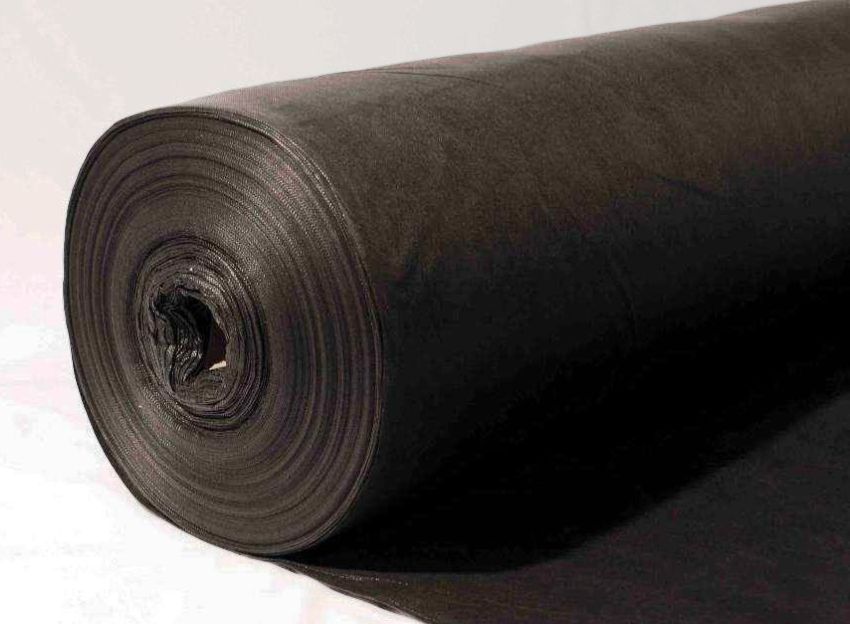
There is a consistently high demand for spunbond, which prompted many foreign and domestic manufacturers to release this versatile material.
Among domestic manufacturers, the companies Spanlab (Ivanovo) and Geomaterials (St.Rostov). The list of companies can be continued. It should be noted that the products are competitive and will satisfy the needs of any gardener.
Related article:
Do-it-yourself greenhouse from a profile pipe: photos of finished structures
How to choose a place and covering material for a structure. Rules for the effective use of a greenhouse.
Covering material lutrasil: application and specifications
Question: “What is lutrasil? – quite often asked by those who have already used or heard about spunbond, but are unfamiliar with this type of coverage. This is also a covering material made of polypropylene and using a similar technology: threads are released from the molten polymer that do not intertwine (non-woven method), but are superimposed on each other and then fastened. It turns out a web-web.
Lutrasil is divided into two types: for plant protection and mulching. Available in white and black. It has a different density and is used for covering seedlings, early shoots, making greenhouses, protecting the soil. White agromaterial provides air exchange, doses sunlight, retains moisture on the surface, protects from low temperatures, that is, creates the conditions necessary for the growth of plants. Black lutrasil does not let in sunlight, prevents weeds and keeps the top layer of the earth moist.
The material is wear-resistant, not affected by moisture and high climatic temperatures. Sold in rolls and packaged. The price of lutrasil does not differ from the cost of other polymer agrotechnics. This material is produced by domestic and foreign manufacturers.
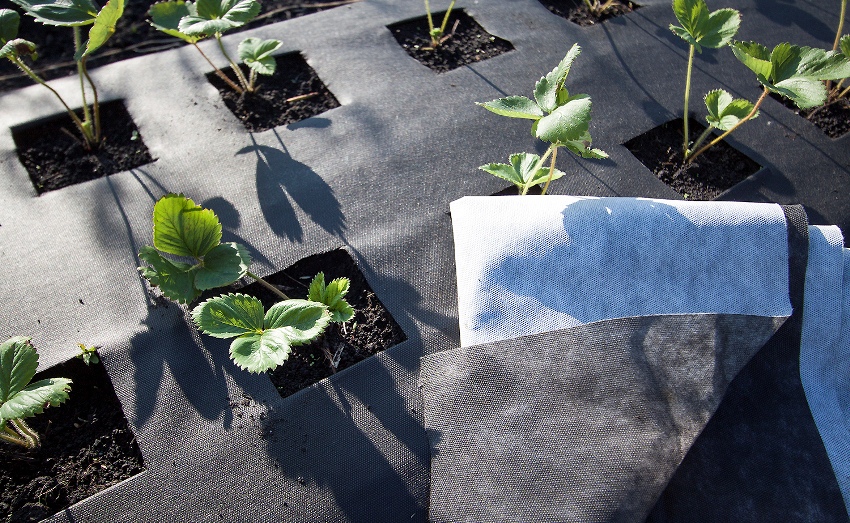
For mulching - preservation of moisture in the soil, reduction of watering, protection from weeds and diseases are used covering material lutrasil
The differences between lutrasil and spunbond are completely insignificant, only the "pattern" that is used when laying the threads differs. The materials are identical in terms of basic quality and functional characteristics.
Helpful advice! When buying a cover sheet, you should consider the density, size and price. All types of nonwovens are made using practically the same technology and have the same quality.
Characteristics of the covering material Agrotex
Along with lutrasil and spunbond, the agrotex covering material is actively used by gardeners, which inherited the name from the trademark of the same name. In the process of making this agrotechnical fabric, the same technology is used as in the production of spunbond: the isolation of polypropylene threads and their fastening. The structure of the web is porous, the density is different.
The main properties of this material are traditional:
- protects plants from sudden weather changes and increases yields;
- light passes through it, thanks to UV stabilizers, plants receive sufficient illumination and are protected from sunburn;
- a greenhouse is created for plants with an appropriate microclimate, which contributes to their rapid growth;
- mulches the soil;
- the tissue is light; in the process of plant growth, it is lifted without damaging it.
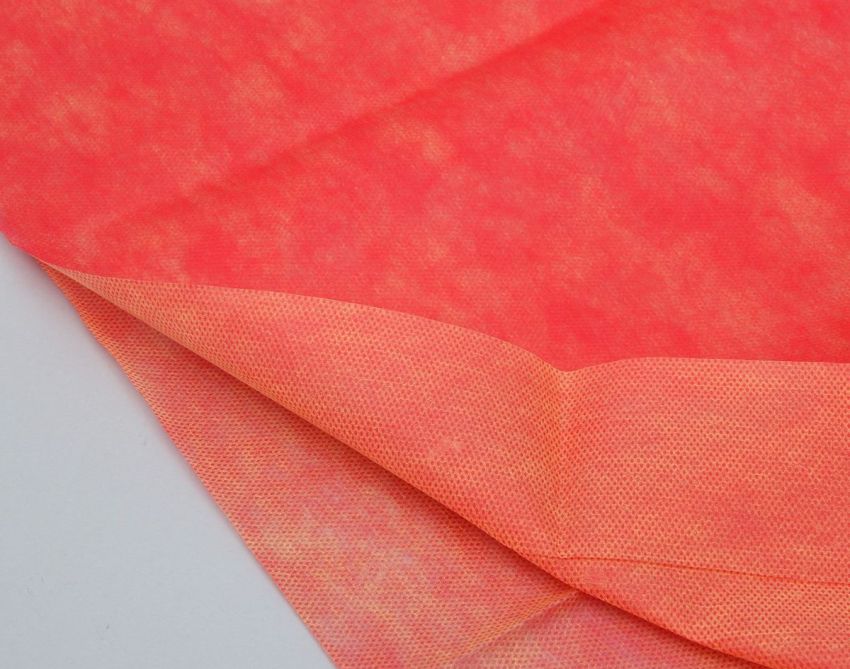
Covering material "Agrotex" has an airy fabric structure, porous and translucent, nevertheless, it is very strong and does not tear
Sold in rolls and packaged, it is made mainly in white and black (there are several types of two-color fabric with a double protective layer). Width 1.6 or 3.2 m, as with other types of covering material.
The black perforated agrotex, which has ready-made holes for planting, is convenient for use. This polymer fabric is intended for planting strawberries in beds, but is also used for other crops that are planted with seedlings (cucumbers, tomatoes, peppers, etc.). Round holes with a diameter of 8 cm are staggered along the canvas at a distance of 30 cm from each other.
Retains all the properties of the mulching material: it allows water to pass through during irrigation, breathes, does not allow moisture to quickly evaporate. The use of this polypropylene material makes it effective and simplifies the process of cultivating garden and horticultural crops:
- removes weeds from the beds;
- saves time and effort (ready-made holes for planting);
- keeps fruits and berries in perfect condition.
If it is not possible to buy perforated material or the dimensions of the holes are not suitable, it is recommended to make them with a sharp knife (you can use a clerical one).
Helpful advice! If the holes are round, it is imperative to make 4-5 cuts around the entire circumference so that the agrotextile does not interfere with the development of the plant.
How to make spunbond greenhouse
Greenhouses made of agricultural fabric are widespread. They are actively used for growing early vegetables. You can buy a spunbond greenhouse. It consists of arcs and the canvas itself, into which the arcs are threaded. The length varies from 2 to 15 m. The density of the fabric is different, it is possible to choose at will and in accordance with the goals and climatic conditions.
It is not difficult to make a greenhouse with your own hands. In order to avoid complaints about the insufficient rigidity of the arcs (as in finished structures), it is better to make them from a plastic pipe by inserting metal rods into the cut points, which will easily and deeply enter the ground. You need to buy a spunbond covering material of the desired width and density and sew the “grooves” on the sewing machine, into which you then insert the arcs.
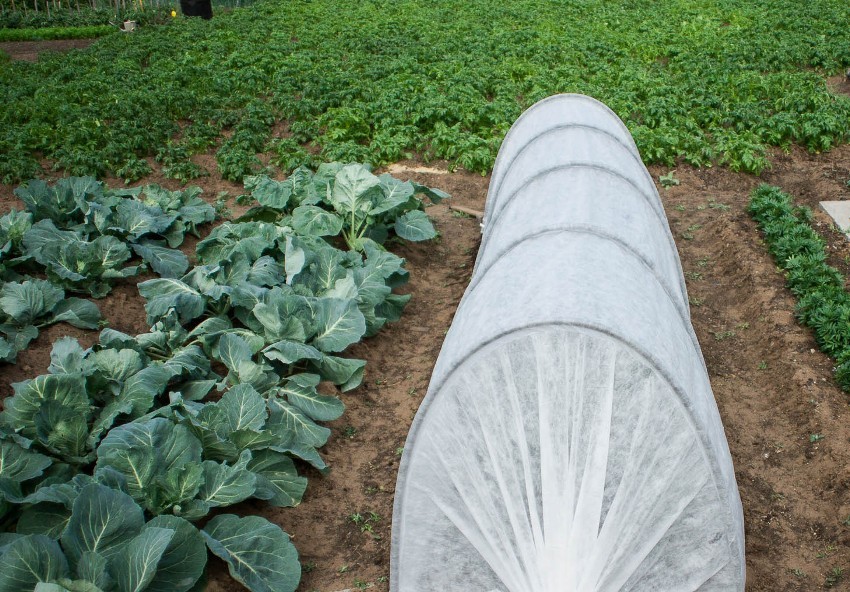
Spunbond makes it easy to create an efficient greenhouse and protect young shoots of various crops from sudden temperature changes
Helpful advice! When choosing the density of the material, one should focus on the intended goals and climate features. The durability of the use of non-woven polymer fabric depends only on proper use and storage.
With a greenhouse height of up to 0.8 m, the arcs should be placed at a distance of 1 m. If the height is much greater, the distance can be increased to 1.5 m. Do not forget that the greenhouse must open in warm daytime. You can also make a simpler design: insert arcs and throw a canvas on top, pressing it to the ground with heavy objects. Such a greenhouse is advisable if used only at night.
The black spunbond: what is it. Using material for a strawberry garden
Strawberries are among the first to ripen. Therefore, it is quite natural that it is affected by unfavorable changes in the still unsettled weather. In addition, it is desirable to speed up the growing season. This berry takes root in the extreme upper layers of the soil, so low temperatures can be fatal for it. Delicate young leaves damage garden pests, and juicy berries rot without sufficient ventilation.
All of the above problems can be solved by planting strawberries on a spunbond. Thanks to carbon black, which is part of the fiber structure, spunbond absorbs more heat, and the soil under such mulch warms up faster, which means that strawberry bushes develop earlier than plants planted in ordinary beds. At the same time, the shelter interferes with the growth of weeds, since they do not receive enough light. In winter, the covering material prevents the soil from freezing.
Proper placement of the black strawberry spunbond is essential for maximum effect. When preparing the site, it is necessary to dig up the soil, removing weeds, apply fertilizers, then level the surface with a rake.
Helpful advice! When preparing the soil for planting strawberries, it is imperative to break up large clods of earth, otherwise an unnecessary space is formed between the covering canvas and the ground, which does not allow creating the desired microclimate.Also, in this position, mechanical damage to agricultural fabric is possible.
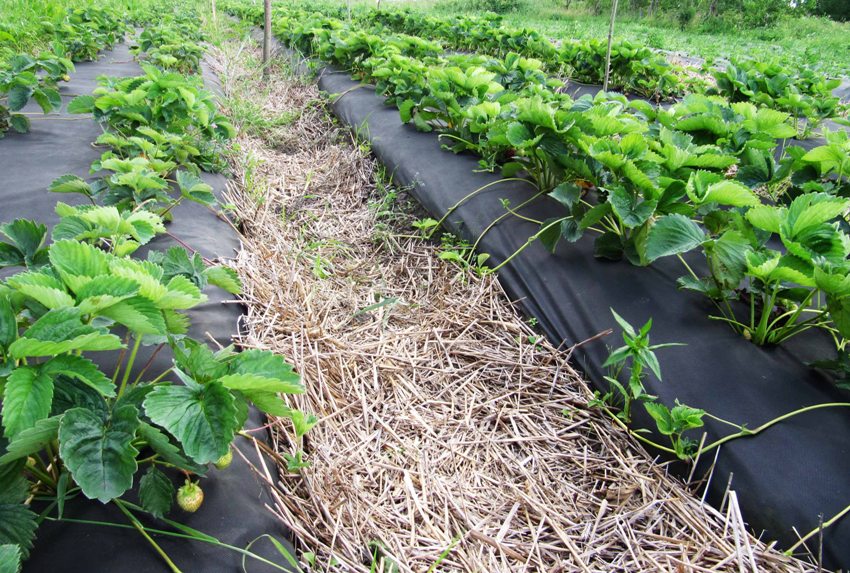
Spunbond mulching allows you to create an optimal microclimate in which the soil will not dry out and weather
The distance between the rows of the beds should not be less than 60 cm, and between the bushes - 30 cm. The strip of spunbond for strawberries should be 20 cm wider and longer than the area that is supposed to be covered. The canvas needs to be spread, cross-shaped cuts are made every 30 cm, then laid on the bed, sprinkled with 10 cm of earth, and tamped. Only then should the disembarkation begin. The covering cloth can not be removed from the garden for 3-4 years, until the need arises to transplant (rejuvenate) strawberries.
Spunbond: what it is. Progress in the production of covering materials
The active use of covering materials made of polypropylene has been going on for at least two decades. This is enough time to get consistent test results. The possibilities of using the covering cloth are expanding: from the protection of seedlings to the preparation of sown areas of considerable size.
With the right targeted use, the economic calculation is convincing: one season is enough for self-sufficiency. Multiple use reduces material costs to almost zero. The storage process is as simple as possible - roll up or fold the canvas. Spunbond is washed, it is not recommended to wring it out and twist it (and it is not necessary), the water drains quickly and the fabric dries out.
It is available in use, does not require the use of special equipment. Lightweight, no significant physical effort required when covering.
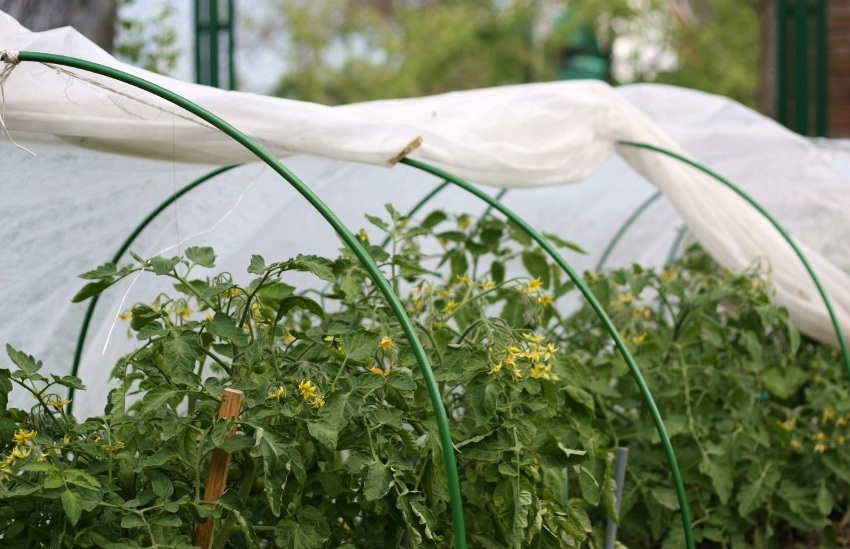
In the process of growing vegetable or fruit and berry crops, you can provide reliable protection of plants from unexpected frosts and other adverse weather events using a spunbond
The main characteristics of spunbond put it in the category of environmentally friendly materials. It does not have any chemical effect on the soil and plants even at the highest daytime temperature.
Availability, efficiency and environmental friendliness are the main distinguishing features of the covering material made using spunbond technology. It gives gardeners and gardeners the opportunity to increase yields, while saving physical strength and time.
